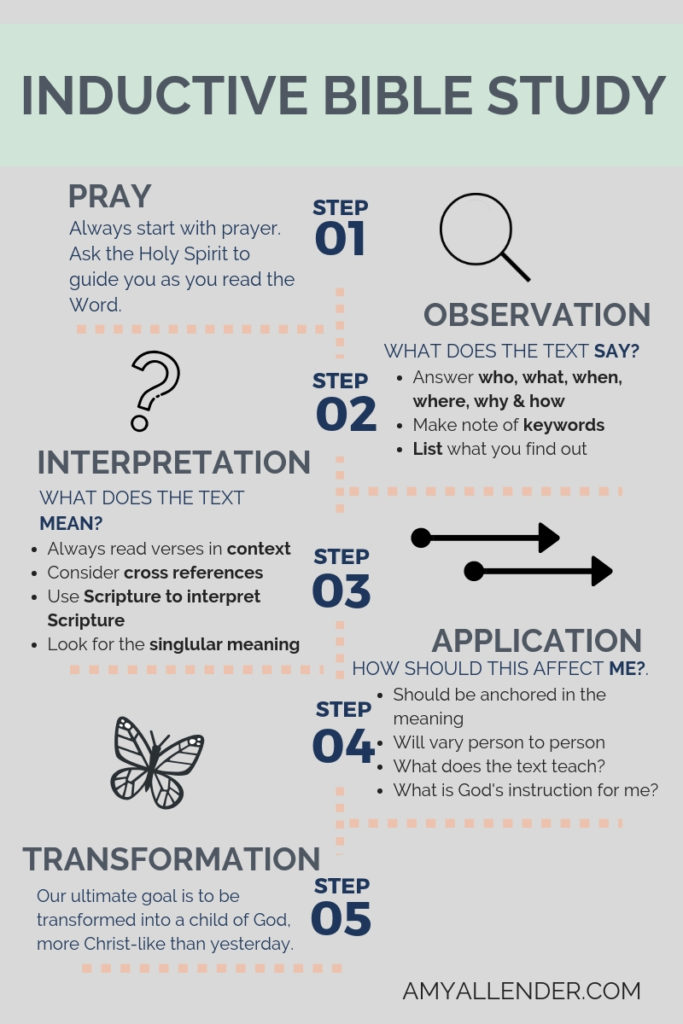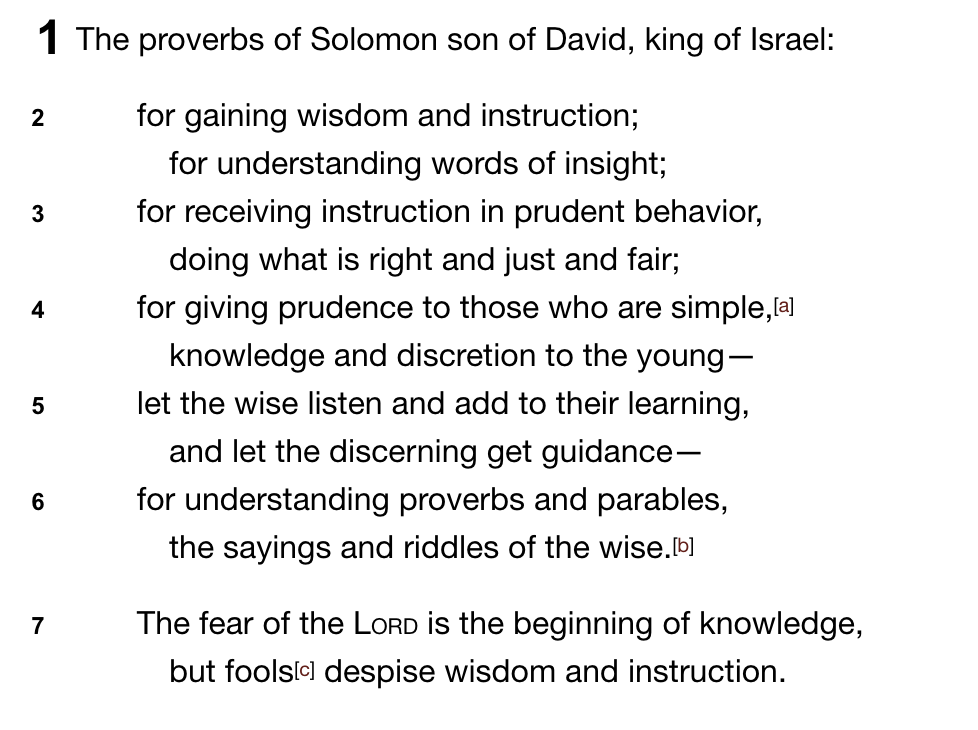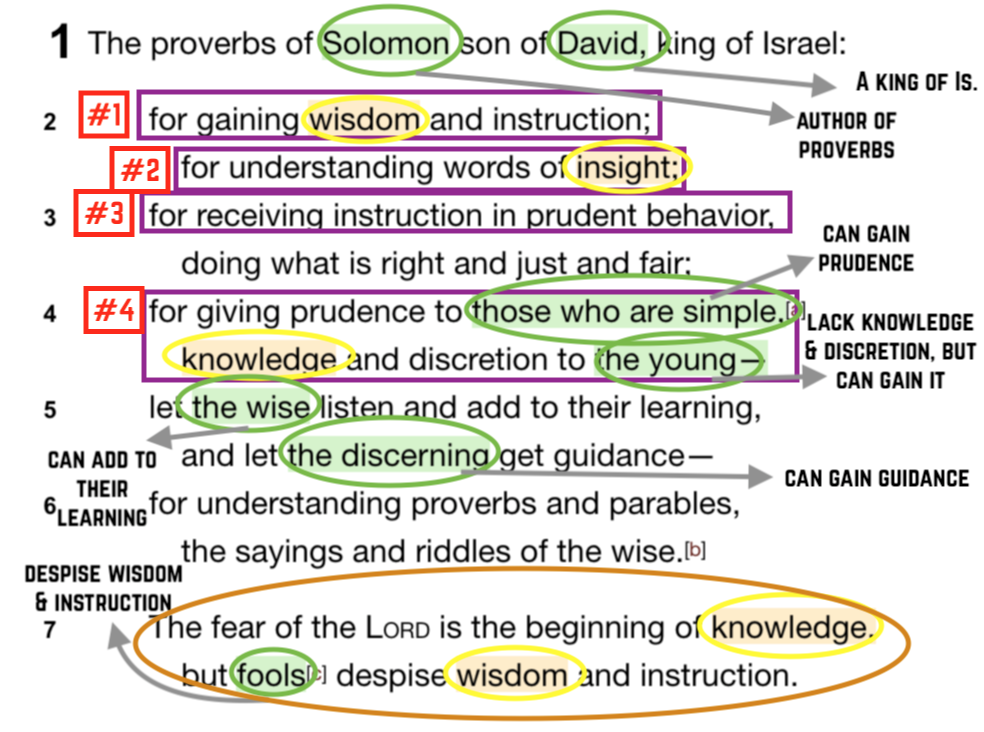A BEGINNER’S GUIDE TO INDUCTIVE BIBLE STUDY

This is a long one. Want the audio version instead? Click Here.
I’ve recently started leading a Bible study. Which you all know I love. We are using the curriculum Savvy from Precepts. It’s written by Pam Gillaspie with Jan Silvious. It’s a fabulous study all about Proverbs and wisdom and applying God’s wisdom to our lives.
Who doesn’t need that, right?
And what’s even more exciting to geeks like me is that this is an Inductive Bible Study. For those of you who haven’t heard of Inductive Bible Study (I hadn’t either until I was asked to lead), it’s a method of studying Scripture. This method will help you:
- Remember what you read–not just move your eyes over the page.
- Know the main point of a passage and be able to consicly communicate that point.
- Understand the message intended by the author.
- Better apply Scripture to every day living.
Our first lesson was basically just going over the method of Inductive Bible Study. I had a fancy Power Point that featured a Boy Meets World reference and used smart graphics–so I felt pretty awesome. But after our meeting, a few ladies asked if I could email out my slides. Yes. Yes, I can. And I can also write up a primer on IBS–wait…that could stand for something non-Bible-study related…
So let’s go.
THIS IS A METHOD FOR READING/STUDYING SCRIPTURE
If you’ve heard of Inductive Study and are a little nervous….or have never heard of it and think it might be complicated, relax. This is a method of studying the Bible. And to be honest, there are parts of the method you’re probably already doing.
THERE ARE THREE STEPS TO INDUCTIVE BIBLE STUDY
- Observation
- Interpretation
- Application
THE ULTIMATE GOAL IS TRANSFORMATION. By thouroughly reading and understanding the Word of God, we aim to apply it to our lives and be transformed. (Sounds good so far!) Now we’ll look at each step….but for those that want a quick fix, I made this infographic.

OBSERVATION: WHAT DOES THE TEXT SAY?
The first step is OBSERVATION. During this step of the process we are only trying to answer the question: WHAT DOES THE TEXT SAY? Nothing else. Don’t try to figure out the deepest secret of Scripture right now. Don’t try to fit this verse in with what your pastor said last Sunday. Just this. Right here in front of you. What does this say?
We accomplish observation through slow, careful reading of the text.
OBSERVATION BASICS
During the observation step, read the text. This can be a passage or chapter(s) or a whole book. Remember, at this point, we are trying to answer the question: what does the text say?
First, things first. Start with prayer. Ask the Holy Spirit to guide you as you study God’s Word.
If you like to write in your Bible, now is the time to get out your favorite pencil, pen, colored pencils and highlighters. You can have a ton of fun creating a system of colors and symbols to identify what you observe. Making such a system (I’ll give you examples in a sec) will help you quickly look back and identify the main point and subject of a passage later on.
Read the text and answer the 5 W’s and H. Who, What, When, Where, Why and How. Just collect information. Make note the answers and anything you learn about the subjects of the answers (the “whos”).
Next, reread and look for KEY WORDS. A key word is vital to the text and is often repeated (synonyms and pronouns referring to the same subject count as the same key word.) If you like marking in your Bible–now is the time. Highlight key words in a way that will help them stand out to you. Precepts encourages marking common key words in a way that is consistent throughout the Bible. For example, the common key word “love” would be marked in the same way, every time you come across it. (Maybe by highlighting it in pink, or drawing a heart around it. Just a couple ideas.)
Finally, make a list of what you know about each person or key word.
OBSERVATION BONUS TOOLS
Here are a few other tools that are handy for observing what Scripture says.
- Look for lists. Sometimes a passage will contain a list. Make note of this. Maybe even write a small 1,2,3…next to each item in the list. Here’s an example, 2 Tim 16-17
- All Scripture is God-breathed and is useful for (1) teaching, (2) rebuking, (3) correcting and (4) training in righteousness,
- Identify comparisons and contrasts. 1 Peter 5:8 shows a comparison.
- Be alert and of sober mind. Your enemy the devil prowls around like a roaring lion looking for someone to devour.
- Watch for expressions of time that will help you put events in order. There are tons of examples, but here is Luke 1:39:
- At that time Mary got ready and hurried to a town in the hill country of Judea,
- Other examples are in those days…, before, after, when, immediately, during, in the year of…, etc
- Look for terms of conclusion. Words like therefore, so then, etc often indicate a summary or conclusion on the horizon. An example is Colossians 3:12:
- Therefore, as God’s chosen people, holy and dearly loved, clothe yourselves with compassion, kindness, humility, gentleness and patience.
- Lastly, try to develop a “Chapter Theme.“ This is a one sentence or Twitter length summary of the chapter. Keep a running list of these in a journal or in your Bible for quick reference. And don’t cheat by copying the chapter title from your Bible.
OBSERVATION PRACTICE (A)
Now let’s practice. Here is Proverbs 1:1-7. Read it and observe who, what, when, where, why and how; keywords; and make lists of what you know. For extra credit, you can use the bonus tools above.

OBSERVATION PRACTICE (B)
Here’s what I observed. (You can see now how making a marking system could be fun…or maybe it gives you anxiety to write in books–so at this point you are thinking you need a pretty new notebook for this exercise.)
I highlighted whos in green. I marked keywords in yellow. I drew a purple square around the why/what. I listed what I found out about each person in the margin. I put an orange circle around a comparison I spotted. And I added red numbers next to each item in a list I found. Your system may be different. You may have even observed a few things I didn’t. But overall, our observations should be similar.

INTERPRETATION: WHAT DOES THE TEXT MEAN?
The next step is INTERPRETATION. In this step, we will answer the question: WHAT DOES THE TEXT MEAN? Now that we have carefully observed the text, we are looking for the single meaning within those verses. Don’t try to interpret what the text means to you. Don’t try to fit the text in with anything else you know or any presumptions you have. Look for the one meaning God intended to communicate in this text.
We accomplish interpretation by asking the Holy Spirit for guidance and carefully considering the Scripture in light of our observations. Remember, God’s Word is for everyone. You can understand it. I can understand it. We don’t need anyone else to tell us what it means when we carefully observe and interpret responsibly.
INTERPRETATION BASICS
To properly interpret Scripture you’ll need to consider it in context. Instead of isolating a single verse, read a passage or an entire chapter. Observe, then interpret the verse or verses you’re focusing on. Considering context also means thinking about the context in which the verse was written. Is the author’s message affected by the culture? The audience? The time? (You’ll have discovered these things through observation.) I love this quote from the Precept website about context
As you study, ask yourself: Is my interpretation of this passage of Scripture consistent with the theme, purpose, and structure of the book in which it is found? Is it consistent with other Scripture about the same subject? Am I considering the historic and cultural context? Never take a Scripture out of its context to make it say what you want it to say. Discover what the author is saying; don’t add to his meaning.
- Here is an example of a verse taken out of context, Philippians 4:13
- “I can do all things through Christ who give me strength.”
- If we only look at this verse it can be said that we can do anything we want, if we are in Christ. By looking at context, we see that Paul is talking about contentment. He can handle any circumstance because of his relationship with Christ.
- Philippians 4:12-13 “I know how to be brought low, and I know how to abound. In any and every circumstance, I have learned the secret of facing plenty and hunger, abundance and need. 13 I can do all things through him who strengthens me.”
To further interpret and understand context you may need to cross reference. Cross referencing simply means seeing what else the Bible has to say on a given subject, keyword, person, etc. I love using Blue Letter Bible to cross reference. Here’s a handy tutorial on how to use their site/app for cross referencing. But you can also use a tangible concordance if that’s more your jam.
In everything that has to do with interpretation, we will be using Scripture to interpret Scripture. All Scripture is God-breathed (2 Tim 3:16) and God is always the same (Heb 13:8). Therefore, Scripture will never contradict itself. The best way to accurately understand the Bible is to understand the full scope of the Bible. When interpreting remember to ask yourself if what you have interpreted about this subject in these verses fits with what is said on the subject elsewhere in the Scripture.
Finally, look for the single meaning in the text. There is a reason a main point is called a main point–there cannot be too many. Finding the single meaning means discovering what the author meant–not what you think the text should mean, not fitting it to support your view, not expressing how it makes you feel. Give yourself freedom to accurately interpret Scripture and be humble enough to accept that a true interpretation may reveal that you’ve been misunderstanding a well known passage for a long time.
INTERPRETATION PRACTICE
Let’s look back at the passage I marked up for Observation Practice.

From this passage, I can interpret that:
The proverbs were written by Solomon to give wisdom to all who would have it.
I come to this interpretation because the text lists many reasons for providing wisdom and states that everyone from the young and simple to wise and discerning can gain wisdom. I know it’s available to all who would have it because the final verse states that there are some people (fools) who despise wisdom.
APPLICATION: HOW SHOULD THIS AFFECT ME?
The next step is APPLICATION. In this step, we will answer the question: HOW SHOULD THIS AFFECT ME? Now that you have observed and interpreted the single meaning of the text, its time to take action. This is the time for customization. A text will cut and dry facts and a singular meaning, but the way we apply the text will be varied.
Proper application will take place by anchoring your application in the meaning. Proper application will ultimately lead to transformation.
APPLICATION BASICS
- James 1:22-25 Tells us to not only hear the Word, but also to be doers. Knowledge is having facts about a subject. Wisdom is applying knowledge to our lives in a meaningful way. Doing something with the insight we gain from Scripture is a vital component to our walk of faith.
- 2 Timothy 3:16-17 gives us a good checklist for application. “All Scripture is God-breathed and is useful for teaching, rebuking, correcting and training in righteousness, 17 so that the servant of Goda] may be thoroughly equipped for every good work.”
- Teaching: God’s Word will teach us by giving us knowledge on a subject or guidelines on behavior. When considering what a passage teaches, remember to ask: Who does this apply to? Is this teaching cultural to the day? Is there an overarching teaching that usurps this one? (ie, the Old Testament law is later fulfilled by Christ’s sacrifice…meaning we no longer need to live by all the nitty gritty details outlined in Leviticus.)
- Rebuking (also translated Reproof): Reproof will show us areas of our lives or thinking that do not align with God’s best for us. Application of reproof is admitting that there is something out of alignment and change our point of view to agree with God. Ask yourself, does what I’ve read expose any wrong in my current actions or thought patterns?
- Correcting: We correct wrong behavior, thoughts, notions by taking active steps to change them. Ask yourself, What instruction does God give me in light of the truth I’ve discovered?
- Training means that through God’s Word we will be ready for anything. But like training for a 5K, or new job, or anything else–it may take time and practice. As you are trained by Scripture, transformation will take place.
APPLICATION PRACTICE
So here’s MY application. As I’ve read and looked at Proverbs 1:1-7, I will probably apply it differently than you. I’ve got a 6 month old, an anxiety pattern and a chronic flesh pattern of fear. So I will consider the questions for application, and do this:
- Pray for a teachable mind and spirit–since the text is clear that wisdom can be learned.
- Align my thinking about wisdom with God. Wisdom can be had by anyone at any station in life. Not only the mature, elderly, experienced.
- Research more about what a proper “fear of the Lord” looks like–since that is the beginning of wisdom.
A FINAL NOTE
Let’s circle back here. Remember. This is a method of study. Don’t get bogged down by all the steps you “have to” take. I’m not your boss. These are ideas and guidelines for an effective and accurate understanding of the Bible. Practice. After a few go’s at it, you’ll have an effective reading workflow that is unique to you.
Give it a try. And let me know what you think! Have you done inductive study before? What do you find helpful? Do you like it?
Amy



